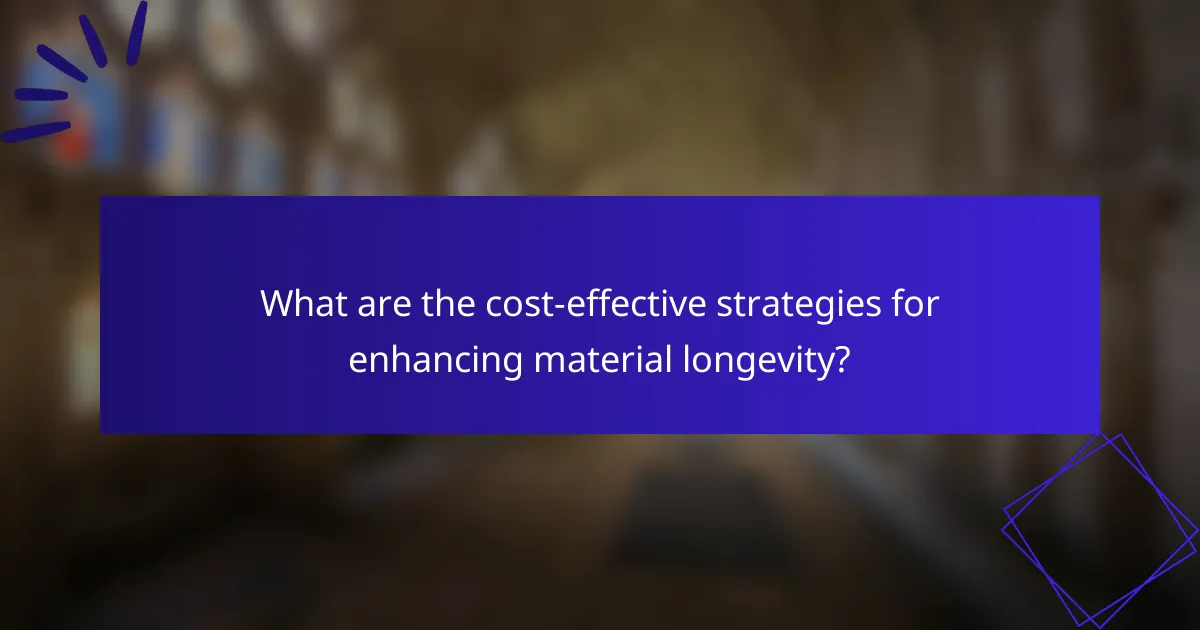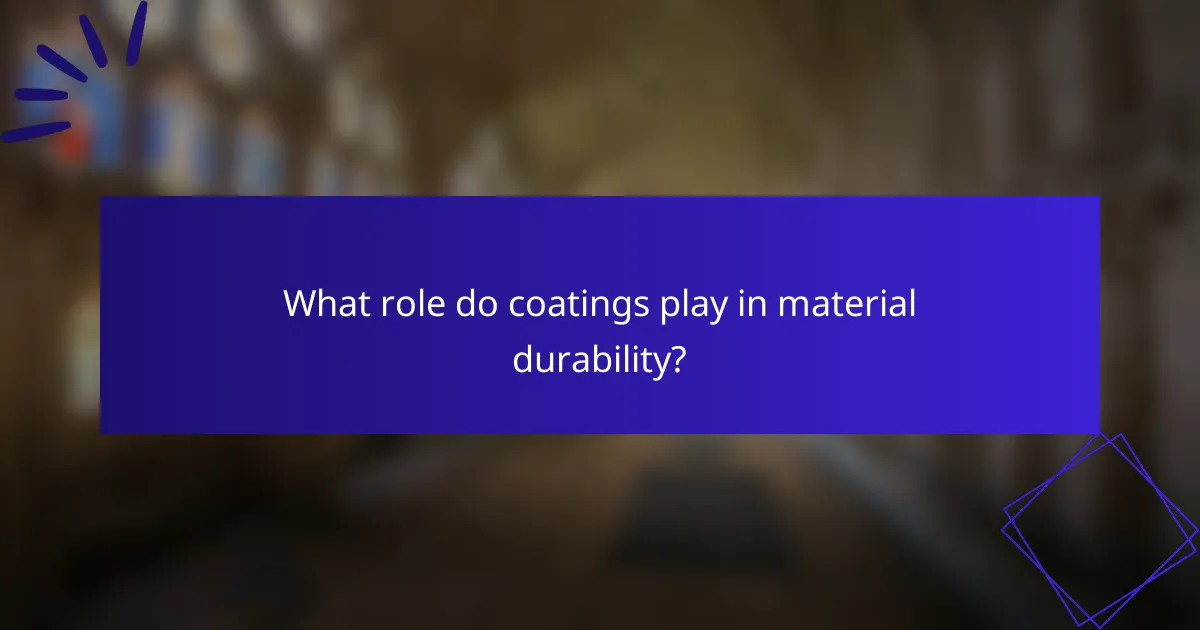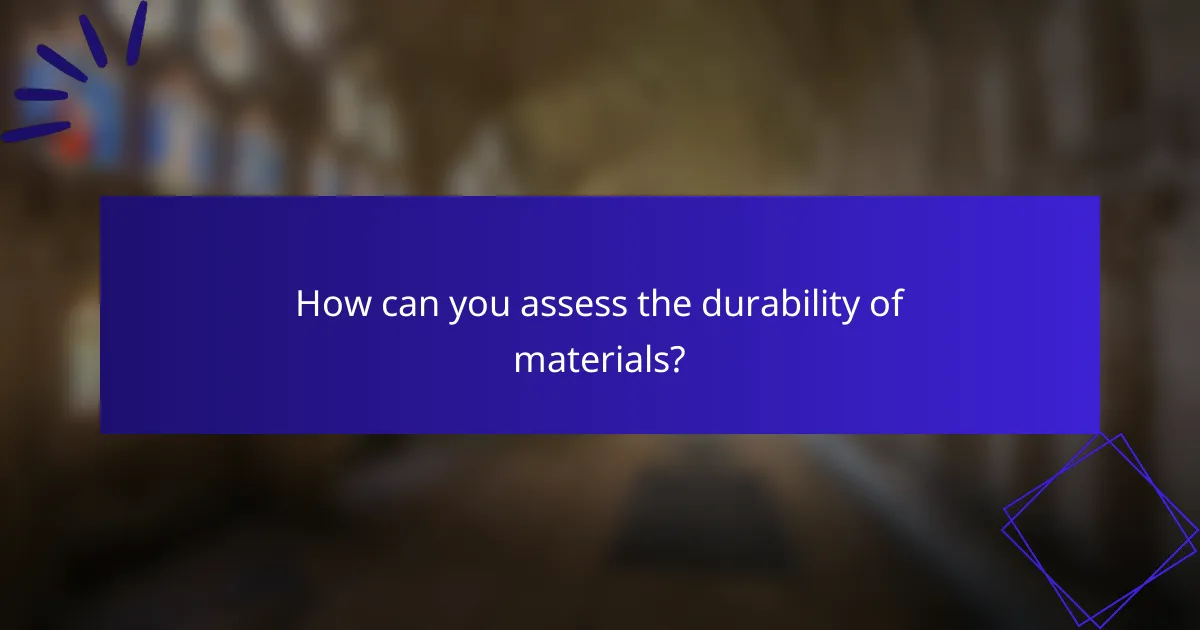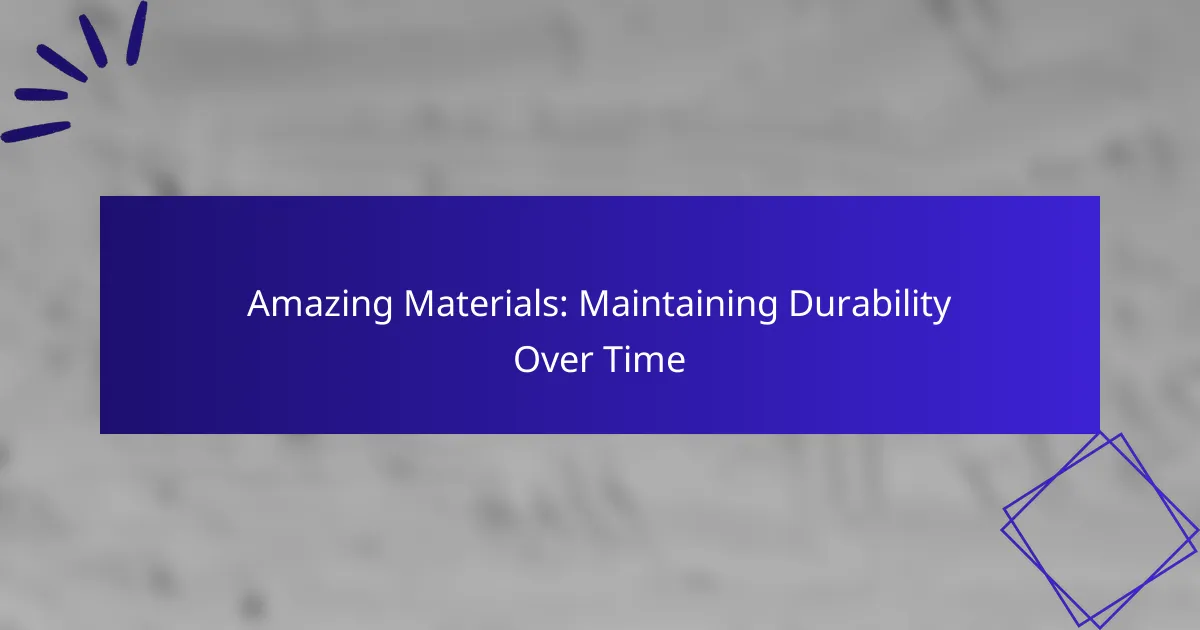Maintaining the durability of materials in construction is essential for extending the lifespan of structures and minimizing repair costs. By selecting high-quality materials such as stainless steel, HDPE, and fiber-reinforced composites, and implementing regular upkeep and protective measures, one can significantly enhance durability. Additionally, considering the impact of climate on material performance is crucial for ensuring long-lasting results in various applications.

How can you maintain the durability of materials in construction?
Maintaining the durability of materials in construction involves regular upkeep, protective measures, and careful selection of quality materials. These practices help extend the lifespan of structures and reduce long-term repair costs.
Regular maintenance schedules
Establishing regular maintenance schedules is crucial for preserving the integrity of construction materials. This includes routine inspections, cleaning, and timely repairs to address wear and tear before it escalates.
For example, scheduling quarterly inspections can help identify issues such as cracks or corrosion early. This proactive approach can save significant costs associated with major repairs later on.
Use of protective coatings
Applying protective coatings is an effective way to enhance the durability of construction materials. These coatings act as barriers against moisture, UV rays, and chemicals that can degrade materials over time.
Common options include sealants for concrete and paints for wood. Selecting the right type of coating based on the material and environmental exposure can significantly prolong its lifespan.
Quality material selection
Choosing high-quality materials is fundamental to ensuring durability in construction. Materials that meet industry standards are often more resilient and require less maintenance over time.
For instance, opting for treated lumber or high-grade steel can prevent issues like rot or rust. Investing in quality upfront can lead to lower lifecycle costs and fewer replacements.
Environmental considerations
Environmental factors play a significant role in the durability of construction materials. Factors such as humidity, temperature fluctuations, and exposure to harsh weather can impact material performance.
When selecting materials, consider local climate conditions and choose options that are specifically designed to withstand those challenges. For example, using weather-resistant materials in coastal areas can prevent premature deterioration.

What are the best materials for long-lasting durability?
The best materials for long-lasting durability include stainless steel, high-density polyethylene (HDPE), concrete with additives, and fiber-reinforced composites. These materials are known for their strength, resistance to environmental factors, and overall longevity, making them ideal choices for various applications.
Stainless steel
Stainless steel is renowned for its corrosion resistance and strength, making it a top choice for construction and manufacturing. It can withstand harsh weather conditions and is easy to maintain, which contributes to its long lifespan.
When selecting stainless steel, consider the grade; for example, 304 and 316 are popular for their durability in outdoor and marine environments. Regular cleaning can help maintain its appearance and prevent surface rust.
High-density polyethylene (HDPE)
High-density polyethylene (HDPE) is a versatile plastic known for its impact resistance and durability. It is commonly used in outdoor furniture, piping, and containers due to its ability to withstand UV radiation and moisture without degrading.
HDPE is lightweight yet strong, making it easy to handle and install. It is also recyclable, which adds an environmental benefit to its long-lasting properties. Look for products labeled as UV-stabilized for enhanced longevity.
Concrete with additives
Concrete with additives, such as fly ash or silica fume, enhances the material’s durability and resistance to cracking and weathering. These additives improve the concrete’s strength and longevity, making it suitable for structures exposed to harsh conditions.
When using concrete, ensure proper mixing and curing techniques to maximize its durability. Consider using waterproofing agents or sealants to further protect against moisture infiltration and extend the lifespan of the concrete.
Fiber-reinforced composites
Fiber-reinforced composites combine materials like fiberglass or carbon fiber with a resin matrix to create a lightweight yet strong product. These composites are resistant to corrosion, making them ideal for applications in marine and industrial environments.
When selecting fiber-reinforced composites, consider the type of fibers used, as they can significantly affect strength and durability. Regular inspections can help identify any wear or damage early, ensuring longevity in use.

How does climate affect material durability?
Climate significantly impacts material durability by influencing how materials respond to environmental factors like humidity, temperature, and UV exposure. Understanding these effects can help in selecting appropriate materials for various applications, ensuring longevity and performance.
Impact of humidity
Humidity levels can lead to material degradation, particularly in organic substances like wood and textiles. High humidity can cause swelling, mold growth, and decay, while low humidity may result in cracking and brittleness.
To mitigate humidity’s effects, consider using moisture-resistant materials or applying protective coatings. Regular maintenance, such as dehumidification in damp environments, can also prolong the lifespan of susceptible materials.
Effects of temperature fluctuations
Temperature fluctuations can cause expansion and contraction in materials, leading to stress and potential failure. Metals may warp, while plastics can become brittle in extreme cold or soften in excessive heat.
When selecting materials, consider their thermal stability and coefficient of expansion. Insulating materials can help minimize temperature variations, protecting the integrity of other components in a structure.
UV exposure considerations
UV exposure can degrade materials, particularly plastics and coatings, leading to discoloration and loss of structural integrity. Prolonged exposure can result in brittleness and cracking, significantly reducing durability.
To protect against UV damage, use UV-resistant materials or apply protective finishes. Regular inspections and maintenance can help identify early signs of degradation, allowing for timely repairs or replacements.

What are the cost-effective strategies for enhancing material longevity?
Cost-effective strategies for enhancing material longevity include implementing preventive maintenance, investing in high-quality materials, and utilizing technology for monitoring. These approaches help extend the lifespan of materials while minimizing replacement costs and resource waste.
Preventive maintenance practices
Preventive maintenance involves regular inspections and upkeep to identify and address potential issues before they escalate. This can include routine cleaning, lubrication, and adjustments according to manufacturer guidelines. For example, in industrial settings, scheduling maintenance every few months can significantly reduce wear and tear on machinery.
Establishing a maintenance schedule based on usage patterns can optimize resource allocation. For instance, equipment used heavily may require monthly checks, while less frequently used items might only need quarterly reviews. Keeping accurate records of maintenance activities can also help in tracking performance and identifying trends.
Investing in high-quality materials
Choosing high-quality materials is crucial for durability and longevity. While the initial cost may be higher, investing in superior materials often leads to lower long-term expenses due to reduced maintenance and replacement needs. For example, opting for stainless steel over standard steel can prevent rust and corrosion, extending the lifespan of products.
When selecting materials, consider factors such as environmental conditions and intended use. Materials designed for specific applications, like UV-resistant coatings for outdoor furniture, can significantly enhance durability. Always compare warranties and performance ratings to ensure you are making informed choices.
Utilizing technology for monitoring
Technology can play a vital role in monitoring material conditions and performance. Sensors and IoT devices can provide real-time data on factors like temperature, humidity, and stress levels, allowing for proactive maintenance. For example, smart sensors in HVAC systems can alert users to potential failures before they occur.
Implementing a monitoring system can help identify patterns that lead to material degradation. Regularly analyzing this data can inform maintenance schedules and material choices, ultimately improving longevity. Consider integrating software solutions that can track and analyze this information efficiently, making it easier to manage resources effectively.

What role do coatings play in material durability?
Coatings enhance material durability by providing a protective layer that shields surfaces from environmental damage, wear, and corrosion. They can significantly extend the lifespan of materials by preventing degradation caused by factors like moisture, UV exposure, and chemical exposure.
Types of protective coatings
There are several types of protective coatings, including paints, varnishes, and specialized coatings like epoxy and polyurethane. Each type serves different purposes; for instance, epoxy coatings are often used in industrial settings for their strong adhesion and resistance to chemicals, while polyurethane coatings are favored for their flexibility and UV resistance.
Other common types include powder coatings, which are applied as a dry powder and cured under heat, providing a tough finish, and ceramic coatings, known for their heat resistance and durability. Selecting the right type depends on the specific application and environmental conditions the material will face.
Application techniques
Coatings can be applied using various techniques, including brushing, rolling, spraying, and dipping. Spraying is often preferred for large surfaces due to its efficiency and even coverage, while brushing is suitable for smaller areas or detailed work.
It’s essential to prepare the surface properly before application, which may involve cleaning, sanding, or priming to ensure optimal adhesion. Following the manufacturer’s guidelines on temperature and humidity during application can also enhance the effectiveness of the coating.
Benefits of coatings
Coatings offer numerous benefits, including improved resistance to abrasion, chemicals, and moisture, which can lead to lower maintenance costs over time. They can also enhance the aesthetic appeal of materials, providing a variety of colors and finishes.
Additionally, coatings can contribute to energy efficiency by reflecting heat or reducing friction, depending on the type used. Overall, investing in quality coatings can significantly enhance the durability and performance of materials in various applications.

How can you assess the durability of materials?
Assessing the durability of materials involves evaluating their ability to withstand wear, pressure, and environmental factors over time. Key considerations include material composition, resistance to corrosion, and performance under stress.
Material Composition
The composition of a material significantly influences its durability. For example, metals like stainless steel are known for their corrosion resistance, while certain plastics can degrade under UV exposure. Understanding the chemical makeup helps predict longevity.
When assessing materials, consider their grade and treatment processes. Higher-grade materials often offer better durability due to enhanced properties, such as increased tensile strength or improved resistance to environmental factors.
Environmental Resistance
Environmental factors play a crucial role in material durability. Materials exposed to moisture, extreme temperatures, or chemicals may degrade faster. For instance, wood can rot in humid conditions, while metals may rust when exposed to saltwater.
To evaluate environmental resistance, look for certifications or standards, such as ASTM or ISO, that indicate a material’s performance in specific conditions. This can guide you in selecting the right materials for your project.
Performance Under Stress
Durability is also determined by how materials perform under mechanical stress. This includes their ability to handle loads, impacts, and fatigue over time. For example, concrete is strong under compression but can crack under tensile stress.
Testing methods such as tensile strength tests or fatigue tests can provide insights into how materials will behave under real-world conditions. Always consider the intended use and load requirements when assessing material durability.
